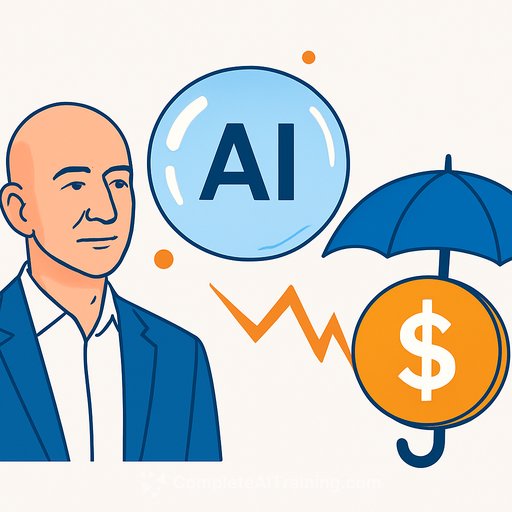Jeff Bezos says this is a "good" AI bubble - what that means for insurance
Jeff Bezos calls AI's surge an "industrial" bubble - the kind that leaves useful infrastructure behind. That may be true. It doesn't make it painless for insurers.
Our job is to price miscalculation and misplaced confidence. History suggests even good bubbles produce messy claims, shaky wordings, and capital drawdowns before the benefits show up.
The risk underwriters actually fear
"Silent AI exposure" is the problem hiding in plain sight. AI threads through professional indemnity, cyber, product liability, and D&O - often without clear triggers or definitions.
Specialty carriers are already pushing back on AI-washing and vague deployments. Developers are struggling to place full cover, assembling bespoke, partially self-insured programs with limited capacity - a signal that the tail risk is hard to price.
If the music stops
A sharp correction hits carriers twice. First through the asset side, where portfolios hold tech equities and credit. Second through liability lines as investors, partners, and consumers seek redress.
Think dot-com déjà vu: shareholder actions, misrepresentation claims, D&O and E&O attritional creep. With AI's layered supply chain, fault attribution will be contested, slow, and expensive.
Why a "good" bubble can still sting insurers
Infrastructure booms leave useful assets - canals, rail, fiber - but they also left underwriters with bruising loss years and years of repricing. Expect the same pattern here.
Even if AI's long-term benefits prove huge, near-term insurance outcomes skew negative: unclear causation, contractual gaps, model error, and correlated vendor failures.
Underwriting moves to make now
- Define "AI" in scope: models, data pipelines, third-party services, and control planes. Avoid catch-all buzzwords.
- Demand evidence of controls: model governance, versioning, audit trails, red-teaming, and incident response.
- Tighten triggers and exclusions: training data IP, model hallucination, automated decision errors, and vendor indemnities.
- Use sub-limits and aggregates for AI-caused loss, especially where causation is hard to isolate.
- Mandate contractual back-to-backs across the AI supply chain; verify indemnity strength, not just wording.
Wording and product hygiene
- Clarify what constitutes an "AI-driven event" across cyber, PI/E&O, product liability, and D&O.
- Address data/IP: scraping, licensing, synthetic data defects, and privacy breaches from model outputs.
- Set conditions precedent for use cases with high automation or consumer impact (credit, hiring, health, safety).
- Add discovery and notification standards for model drift, data poisoning, and prompt-injection incidents.
Portfolio and capital discipline
- Map concentration: top vendors, cloud dependencies, model families, and critical open-source components.
- Run stress tests: model failure cascade, regulatory shock, and tech-valuation drawdown hitting both assets and liabilities.
- Cap net line on AI-heavy sectors and clients with high automation in core operations.
- Price systemic correlation - don't treat AI incidents as independent events.
Claims readiness
- Build playbooks for causation: log capture, model/version forensics, data lineage, and third-party audit requests.
- Train panels on AI-specific defenses and apportionment across vendors and clients.
- Prepare for blended claims spanning cyber, PI, and product liability under one incident.
What brokers should coach clients to do
- Document model governance: policies, approvals, human-in-the-loop, and rollback plans.
- Tighten vendor contracts: SLAs for model performance, data warranties, IP indemnities, and evidence of security testing.
- Run scenario exercises on automated decision errors and public/regulatory response.
- Clean up data rights: licensing, consent, retention, and model training permissions.
Regulatory and systemic signals to watch
- Valuation warnings and leverage trends in financial stability updates from central banks and multilaterals.
- Sector-specific guidance on AI safety, auditability, and automated decision-making.
Useful references: IMF Global Financial Stability Report and the Bank of England's Financial Stability resources.
The practical takeaway
Bet on AI's long-term utility, price for short-term pain. Tighten wordings, cap accumulations, and prefer clients with measurable controls and clear liability trails.
If you need to upskill teams on AI fundamentals and risk controls, scan role-based options here: Complete AI Training - Courses by Job.
Bottom line
Bezos might be right: this could be a "good" bubble for society. For insurers, the win is staying solvent through the messy middle - by making ambiguity expensive, controls mandatory, and correlation explicit.
Your membership also unlocks:






